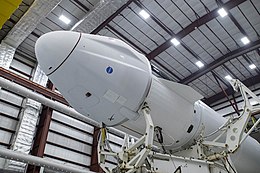| C208 | |
|---|---|
 C208 at Kennedy in August 2021. | |
| Type | Space capsule |
| Class | Dragon 2 |
| Owner | SpaceX |
| Manufacturer | SpaceX |
| Specifications | |
| Dimensions | 4.4 m × 3.7 m (14 ft × 12 ft) |
| Power | Solar panel |
| Rocket | Falcon 9 Block 5 |
| History | |
| Location | Hawthorne, California |
| First flight |
|
| Last flight |
|
| Flights | 5 |
| Flight time | 175 days, 13 hours and 52 minutes |
| Dragon 2s | |
Dragon C208 is the first Cargo Dragon 2 spacecraft, and the first in a line of International Space Station resupply craft which replaced the Dragon capsule, manufactured by SpaceX. The mission is contracted by NASA under the Commercial Resupply Services (CRS) program. It flew for the first time on the CRS-21 mission on 6 December 2020. [1] This was the first flight for SpaceX under NASA's CRS Phase 2 contract awarded in January 2016. This was also the first time a Cargo Dragon was docked at the same time as a Crew Dragon spacecraft (SpaceX Crew-1). This mission used Booster B1058.4.






